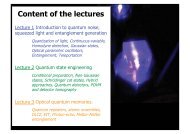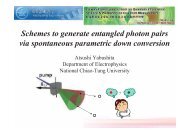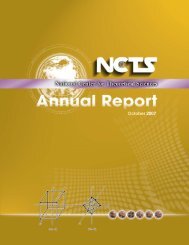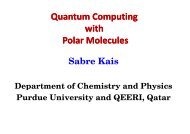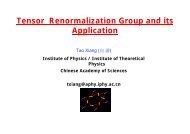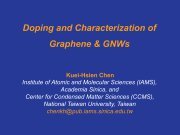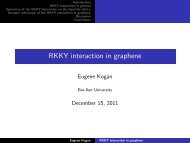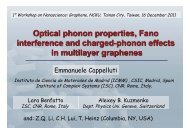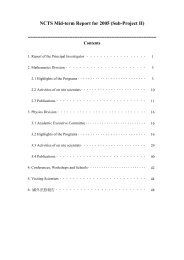Quantum Dynamics of Josephson Junction Based Circuits(III)
Quantum Dynamics of Josephson Junction Based Circuits(III)
Quantum Dynamics of Josephson Junction Based Circuits(III)
You also want an ePaper? Increase the reach of your titles
YUMPU automatically turns print PDFs into web optimized ePapers that Google loves.
<strong>Quantum</strong> dynamics in<br />
nano <strong>Josephson</strong> junctions<br />
Permanent:<br />
Wiebke Guichard<br />
Olivier Buisson<br />
Frank Hekking<br />
Laurent Lévy<br />
Bernard Pannetier<br />
CNRS – Université Joseph Fourier<br />
Institut Néel- LP2MC<br />
GRENOBLE<br />
Scientific collaborations: PTB Braunschweig ( Germany)<br />
LTL Helsinki (Finland)<br />
Rutgers (USA)<br />
Projects: ANR QUNATJO<br />
PhD:<br />
Thomas Weissl<br />
Etienne Dumur<br />
Ioan Pop<br />
Florent Lecocq<br />
Aurélien Fay<br />
Rapaël Léone<br />
Nicolas Didier<br />
Julien Claudon<br />
Franck Balestro<br />
Post-doc:<br />
Alexey Fe<strong>of</strong>anov<br />
Iulian Matei<br />
Zhihui Peng<br />
Emile Hoskinson<br />
Alex Zazunov
Introduction<br />
Multi-level quantum<br />
system<br />
Two-degrees <strong>of</strong><br />
freedom<br />
I <br />
10µm<br />
I b<br />
Multi-degrees <strong>of</strong><br />
freedom<br />
New physics…<br />
10µm
Outline<br />
Two-degrees <strong>of</strong> freedom artificial atom<br />
- inductive dc SQUID<br />
- spectroscopy measurements<br />
- strong non-linear coupling<br />
- coherent oscillations<br />
Multi-degrees <strong>of</strong> freedom system<br />
- <strong>Josephson</strong> junction chains<br />
- quantum phase slip<br />
- charging effects
Motivations : two degrees <strong>of</strong> freedom<br />
Trapped ion NV centers in diamond<br />
Leibfried, Rev.Mod.Phys (2003)<br />
Blatt and Wineland, Nature (2008)<br />
Superconducting artificial atom<br />
with multiple degrees <strong>of</strong> freedom ?<br />
Jelezko et al, PRL (2004)<br />
High fidelity readout & Electromagnetically Induced Transparency
Modes <strong>of</strong> oscillations<br />
where
L < L josephson<br />
( b > 1 )<br />
4<br />
Parameter <strong>of</strong> dimensionality<br />
where<br />
4<br />
L > L josephson<br />
( b < 1 )<br />
6
=3<br />
<strong>Dynamics</strong> close to a minimum<br />
Expansion in X and Y directions :<br />
s<br />
7
=3<br />
<strong>Dynamics</strong> close to a minimum<br />
Expansion in X and Y directions :<br />
s<br />
8
=3<br />
<strong>Dynamics</strong> close to a minimum<br />
Expansion in X and Y directions :<br />
s<br />
9
=3<br />
<strong>Dynamics</strong> close to a minimum<br />
Expansion in X and Y directions :<br />
s<br />
10
L < L josephson<br />
Claudon, et al , PRL, 2004<br />
Hoskinson and Lecocq , et al , PRL, 2009<br />
Palomaki, et al , PRB, 2010<br />
4<br />
From a phase qubit …<br />
Transverse mode high in energy<br />
Considered in the ground state<br />
1D dynamics<br />
11 1
L > L josephson<br />
4<br />
…to a 2D oscillator<br />
Transverse mode energy decreased<br />
12
Outline<br />
1 Introduction :<br />
1D and 2D dynamics in a dcSQUID<br />
2 Spectroscopic evidence <strong>of</strong> the transverse mode<br />
and coherent manipulation<br />
3 Using the non linear coupling :<br />
coherent oscillations between internal modes<br />
13
dcSQUID in aluminum<br />
Fabricated by shadow evaporation<br />
without suspended bridges<br />
(Controlled Undercut Technique ) F.<br />
Lecocq, et al , ArXiv 1101.4576v2<br />
F. LECOCQ<br />
Moriond 2011<br />
Experimental Setup<br />
14
Measurement technique :<br />
Switching to the voltage state<br />
Experimental Setup<br />
Nanosecond<br />
flux pulse<br />
Escape = voltage = detection<br />
15
Spectroscopy<br />
Longitudinal mode<br />
Transverse mode
Spectroscopy<br />
Large anti-crossing at<br />
the resonance<br />
between and<br />
Non linear coupling<br />
Also discussed in quantum<br />
optics and ion traps<br />
Bertet et al, PRL (2002)<br />
Vogel and Dematos, PRA (1995)<br />
Strong coupling regime
Coherent oscillations <strong>of</strong> the two modes<br />
T 1 = 75ns<br />
T 1 = 200ns
Outline<br />
1 Introduction :<br />
1D and 2D dynamics in a dcSQUID<br />
2 Spectroscopic evidence <strong>of</strong> the transverse mode<br />
and coherent manipulation<br />
3 Using the non linear coupling :<br />
coherent oscillations between internal modes<br />
19
Coherent oscillation between modes<br />
(a)<br />
(b)<br />
Non linear coupling, strong ~700MHz
Coherent oscillation between modes<br />
Coherent exchange <strong>of</strong> quanta<br />
between the modes<br />
Frequency conversion<br />
back and forth<br />
FFT
A dcSQUID with a large loop inductance<br />
can be describe as two coupled oscillator<br />
Non linear coupling<br />
( exchange <strong>of</strong> 2 quanta in one mode, 1<br />
quantum in the other)<br />
Conclusion<br />
Artificial atom with<br />
two degrees <strong>of</strong> freedom…
<strong>Quantum</strong> dynamics in <strong>Josephson</strong> junction chains<br />
Single <strong>Josephson</strong> (SQUID) junction chains<br />
Wiebke Guichard<br />
PhD: I. Pop<br />
Fundamental research:<br />
- collective behavior in multi-degrees <strong>of</strong> freedom system<br />
- <strong>Quantum</strong> Phase-Slips<br />
(Mateveev, Larkin, Glazman, PRL2002)<br />
Possible applications: Current standard<br />
New type <strong>of</strong> qubits topologically protected
ˆ ˆ 2<br />
H E ( Q / e)<br />
<br />
d<br />
C<br />
2<br />
d <br />
( / 2)<br />
2<br />
<strong>Quantum</strong> phase-slip in a single junction<br />
<br />
Q, 2ie<br />
Schrödinger equation:<br />
E E <br />
J <br />
<br />
cos<br />
<br />
<br />
<br />
EC<br />
EC<br />
<br />
Exponentially small<br />
overlap <strong>of</strong><br />
E<br />
J<br />
E J slightly larger<br />
than E C<br />
cos<br />
ˆ<br />
0<br />
V=E J cos<br />
8EJ EC<br />
Phase-slip<br />
<br />
3 1/<br />
4<br />
rate E J EC<br />
exp 8EJ<br />
/ EC<br />
Gaussian tails<br />
<br />
<br />
p<br />
<br />
<br />
/ <br />
Gaussian<br />
wave function
E Pot=-E Jcos()<br />
Phase biased <strong>Josephson</strong> junction chain<br />
N <strong>Josephson</strong> junctions in series<br />
1 j <br />
N Phase-slip<br />
<br />
i<br />
<br />
N<br />
<br />
i<br />
<br />
Phase slip rate in a chain:<br />
<br />
j<br />
<br />
2<br />
<br />
N N<br />
N<br />
N<br />
<br />
i1<br />
<br />
<br />
i<br />
N
E<br />
pot<br />
<br />
<br />
i<br />
<br />
i<br />
NE<br />
<br />
N<br />
E<br />
J<br />
“Classical regime”: E J large and E C =0<br />
1 2 N<br />
N J<br />
[ 1cos(<br />
)]<br />
[ 1cos(<br />
/ N)]<br />
i<br />
<br />
<br />
i1<br />
<br />
i<br />
NE J<br />
E()<br />
2N
E<br />
2<br />
i<br />
2<br />
N N<br />
2<br />
j <br />
N N<br />
pot<br />
<br />
<br />
<br />
i<br />
NE<br />
NE<br />
E<br />
J<br />
J<br />
J<br />
“quasi-classical regime ”: E J >>E C<br />
1 2 N<br />
N [ 1cos(<br />
)]<br />
[ 1cos(<br />
/ N)]<br />
[ 1cos((<br />
-2 ) / N)]<br />
i<br />
<br />
Phase-slip<br />
<br />
i1<br />
NE J<br />
<br />
i<br />
E()<br />
2N
1 2 N<br />
N Low energy levels<br />
<strong>of</strong> the chain:<br />
E<br />
m<br />
EJ<br />
( 2m<br />
)<br />
2N<br />
Critical current <strong>of</strong> chain:<br />
I<br />
chain<br />
c<br />
<br />
“quasi-classical regime ”: E J >>E C<br />
I<br />
N<br />
c<br />
2<br />
<br />
Phase-slip<br />
<br />
i1<br />
NE J<br />
<br />
i<br />
E()<br />
2N
E()<br />
m-1<br />
“<strong>Quantum</strong> regime”: E J >E C<br />
<br />
<br />
i1<br />
1 2 N ~/N<br />
q 1<br />
<br />
chain<br />
m<br />
<br />
q 2<br />
m+1<br />
H<br />
N<br />
<br />
/2<br />
<br />
i<br />
EJ<br />
2N<br />
<br />
m<br />
2mˆ <br />
chain<br />
q N-1<br />
<br />
1/<br />
4<br />
E E exp<br />
8E<br />
E <br />
3<br />
<br />
N /<br />
J<br />
C<br />
J<br />
(<br />
C<br />
2<br />
<br />
m 1<br />
m<br />
<br />
<br />
m<br />
m 1<br />
)<br />
Matveev et al (2002)
C<br />
Experimental verification <strong>of</strong> the quantum-phase slip model<br />
in a 6 <strong>Josephson</strong> junctions chain<br />
Idea:<br />
tune strength <strong>of</strong> quantum<br />
fluctuations with flux<br />
SQ<br />
J<br />
E E f<br />
J ( f ) cos( )<br />
<br />
E E<br />
I<br />
I<br />
Readout<br />
c<br />
SQUID<br />
c<br />
E<br />
SQUID<br />
J<br />
E<br />
c<br />
<br />
3<br />
C<br />
330nA<br />
83nA<br />
6 SQUID chain<br />
Read-out junction<br />
Nan<strong>of</strong>ab-facility
I chain ()<br />
I b<br />
Measurement circuit<br />
<br />
<br />
I c<br />
Statistic <strong>of</strong> N=10 000 events<br />
Switching event:<br />
I I ( ) <br />
b<br />
2 C / 0 /<br />
50%<br />
chain<br />
I SW<br />
I<br />
C<br />
2
R<br />
R<br />
E<br />
E<br />
Measurement <strong>of</strong> the ground state <strong>of</strong> the chain<br />
as a function <strong>of</strong> bias phase<br />
Switching current at 50%<br />
escape probability<br />
SQUID<br />
Readout<br />
J<br />
C<br />
2 K<br />
<br />
<br />
968 <br />
0.<br />
66<br />
3.<br />
87<br />
K<br />
k<br />
I. Pop, et al., Nature Physics (2010)<br />
Good agreement with quantum phase-slip model
Strong quantum fluctuations<br />
Chain with phase-slip amplitude ~0<br />
I. Pop, et al., Nature Physics (2010)<br />
Measuremen<br />
Theory
Conclusion<br />
- Evidence <strong>of</strong> quantum phase slips<br />
in a short <strong>Josephson</strong> junction chains<br />
- Current-phase relation: I=I c chain sin(d)<br />
- Ground state well understood<br />
What about excited states?<br />
- Current standard in a chain?<br />
With microwave irradiation<br />
W. Guichard and F. Hekking,<br />
Phys. Rev B (2010)
Conclusion<br />
Superconducting quantum circuits:<br />
- controllable artificial atoms<br />
- model system for quantum experiments<br />
- adjustable circuits parameters to reach:<br />
- qubits<br />
- multilevel system<br />
- 2D properties<br />
- multi-degrees <strong>of</strong> freedom system<br />
In the future:<br />
- reproduction <strong>of</strong> well known atomic or quantum optics experiments<br />
- realization <strong>of</strong> new quantum experiments and phenomena
Projects:<br />
ANR QUNATJO<br />
THANK YOU TO!<br />
Wiebke Guichard, Bernard, Pannetier,<br />
Frank Hekking, Laurent Lévy, Cécile Naud,Ioan Pop,<br />
Iulian Matei, Florent Lecocq, Zihui Peng<br />
and <strong>Quantum</strong> Coherence group<br />
Cryogénie:<br />
Pierre Chantib, Guillaume Donnier-Valentin,<br />
Christian Gianese, André-Julien Vialle, Anne Gerardin,<br />
Henri Godfrin…<br />
SERAS:<br />
Cyril Bruyère, Olivier Tissot…<br />
Service électronique:<br />
Olivier Exshaw, Maurice Grollier, Jean-Luc Mocellin,<br />
Christophe Gutin, Julien Minet…<br />
Nan<strong>of</strong>ab:<br />
Thierry Fournier, Thierry Crozes, Christophe Lemonias….<br />
Administration:<br />
Nathalie Bourgeat-Lami, Caroline Bartoli, Assya Achour,<br />
Véronique Fauvel, Louise Infuso, Sabine Gadal, Marielle<br />
Lardato, Christine Martinelli,<br />
Martine Lemoine, Jessica Fernandez<br />
and all others I forgot…<br />
Service informatique<br />
Liquefacteur





